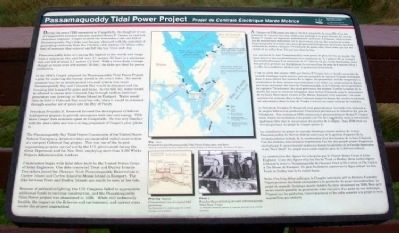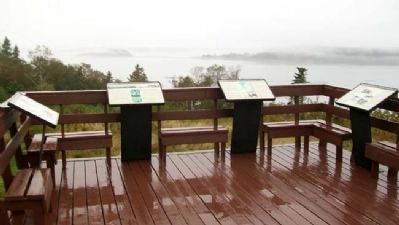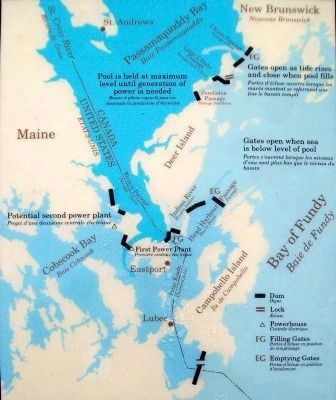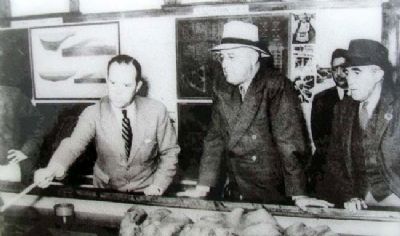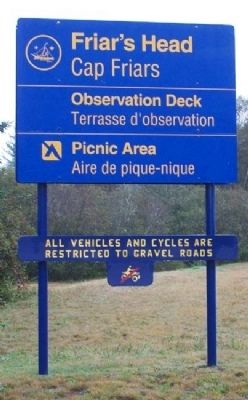Near Welshpool in Charlotte County, New Brunswick — The Atlantic Provinces (North America)
Passamaquoddy Tidal Power Project
Projet de Centrale Électrique Marée Motrice
Inscription.
During the years FDR summered on Campobello, the daughter of one of Campobello's summer colonists married Dexter P. Cooper, an eminent American engineer. Cooper studied the tremendous rise and fall of Passamaquoddy Bay's tides and became obsessed with the potential of generating electricity from the 2 billion cubic metres (70 billion cubic feet) of seawater that entered and left the bay twice each day.
Passamaquoddy tides are among the highest in the world, and range from a maximum rise and fall near 9.1 metres (30 feet) to a minimum rise and fall of about 3.7 metres (12 feet). With a twice-daily average change in water level of 6 metres (20 feet), the tides are ideal for power production.
In the 1930's, Cooper proposed the Passamaquoddy Tidal Power Project, a plan for capturing the energy stored in the area's tides. His initial proposal was for an international two-pool system (see map). Passamaquoddy Bay and Cobscook Bay would be dammed and the incoming tide trapped by gates and dams. As the tide fell, water would be allowed to escape into Cobscook Bay through turbine electrical generators (see drawing) at Moose Island in Eastport. Water would then be held in Cobscook Bay until low tide, when it would be released through another set of gates into the Bay of Fundy.
President Franklin D. Roosevelt favored the development of federal hydropower projects to provide consumers with low-cost energy. FDR knew Cooper from summers spent on Campobello. He was very familiar with the area's tides and was a strong proponent of Cooper's plan (photo 1).
The Passamaquoddy Tidal Power Project Commission of the United States Federal Emergency Administration recommended initial construction of a one-pool Cobscook Bay project. This was one of the largest engineering projects carried out by the U.S. government during the Great Depression and the New Deal, employing more than 3,000 Works Projects Administration workers.
Construction began with tidal dikes built by the United States Corps of Army Engineers. One dike connected Treat and Dudley Islands. Two others joined the Pleasant Point Passamaquoddy Reservation to Carlow Island and Carlow Island to Moose Island in Eastport. The dike between Treat and Dudley Islands can easily be seen at low tide.
Because of political infighting, the U.S. Congress failed to appropriate additional funds to continue construction, and the Passamaquoddy Tidal Power [P]roject was abandoned in 1936. While still technically feasible, the impact on the fisheries and environment, and current costs render the project impractical.
—————————
Á l'époque où FDR passa ses étés
à l'île de Campobello, la jeune fille d'un des habitants de colonies estivales célébra son mariage à un jeune homme du nom de Dexter P. Cooper, un ingénieur professionnel américain. Á l'époque, celui-ci avait fait de nombreuses recherches sur le mouvement intense des marées de la baie Passamaquoddy et il était convaincu du potentiel énergétique provenant des deux milliards de mètres cubiques (70 milliards de pieds cube) d'eau salée qui fait son entrée et sa sortie deux fois par jour dans la baie.
Les marées de la baie Passamaquoddy sont parmi les plus élevées au monde. On peut observer des montées/baisses d'un maximum de 9.1 mètres (30 pi.) jusqu'a des montées/baisses d'un minimum 3.7 mètres (12 pi.). Cette fluctuation, deux fois par jour, produit un changement du niveau d'eau de près de 6 mètres (20 pi.) et offre des conditions idéales la production d'électricité.
C'est au cours de années 1930 que Dexter P. Cooper mit en branle son projet de centrale électrique marée motrice pouvant permettre de capturer l'énergie entreposée dans le mouvement des marées de la région. Sa proposition initiale comprenait la construction de deux bassins internationaux (voir carte). La construction de digues aux deux extrémités des baies de Passamaquoddy et de Cobscook devait permettre de capturer l'écoulement des eaux provenant des marées. Lors de la baisse de la marée, les eaux
se seraient échappées dans la baie Cobscook, sous le mouvement de turbines électriques situées à l'île Moose, Eastport (voir esquisse). Les eaux auraient été retenues dans la baie Cobscook jusqu'à la baisse des marées et auraient été acheminées dans la baie de Fundy à travers un autre système de conduits.
Le Président Franklin D. Roosevelt était généralement favorable à la réalisation de projets fédéraux de production d'électricité permettant la réduction des prix de l'électricité. Non seulement FDR connaissait-il personnellement Dexter P. Cooper, étant donné ses nombreux étés passés sur l'île de Campobello, mais il connaissait également très bien le mouvement des marées de la région. Donc, FDR était un fervent partisan du projet de Cooper (photo 2).
La commission de projet de centrale électrique marée motrice de la baie Passamaquoddy du Service fédéral américain de la gestion d'urgence fit la recommandation initiale de la construction d'un des bassins de la baie Cobscook. Une fois réalisée, cette initiative représentait l'un des plus grands projets d'ingénierie entrepris par le gouvernement américain durant les périodes de la Grande dépression et du "New Deal". Ce projet aura aussi employé plus de 3,000 travailleurs.
La construction des digues fut entreprise par le United States Corps of Army Engineer[s]. L'une des digues relia les îles de Treat et Dudley. Deux autres digues relièrent la réserve Passamaquoddy de Pleasant Point à i'île Carlow et l'île Carlow à i'île Moose de Eastport. On peut facilement apercevoir la digue reliant les îles Treat et Dudley lors de la marée basse.
Suite d'un long débat politique, le Congrès américain prit la décision d'annuler l'appropriation des fonds nécessaires à la poursuite du projet deconstruction. Le projet de centrale électrique marée motrice fut donc abandonné en 1936. Bien qu'il serait encore possible de poursuivre cette initiative d'un point de vue technique, l'impact sur les pêcheries, l'environnement et les coûts associés à ce projet le rend aujourd'hui peu réaliste.
—————————
Map.
Proposed two-pool Passamaquoddy Tidal Power Project gates and dams.
Carte.
Projet de construction des deux bassins de la centrale électrique de Passamaquoddy - les ports et les digues.
Photo 1.
President Roosevelt looking at model of Passamaquoddy Tidal Power Project.
Le Président Roosevelt examine la maquette du projet de la centrale électrique.
Erected by Roosevelt Campobello International Park.
Topics and series. This historical marker is listed in these topic lists: Environment •
Man-Made Features • Waterways & Vessels. In addition, it is included in the Former U.S. Presidents: #32 Franklin D. Roosevelt series list. A significant historical year for this entry is 1936.
Location. 44° 52.575′ N, 66° 58.315′ W. Marker is near Welshpool, New Brunswick, in Charlotte County. Marker is at the Friar's Head/Cap Friars Observation Deck accessed off Provincial Road 774, about 0.7 miles west of the main entrance to Roosevelt Campobello International Park. Touch for map. Marker is in this post office area: Welshpool NB E5E 1A4, Canada. Touch for directions.
Other nearby markers. At least 8 other markers are within walking distance of this marker. Roosevelt Campobello International Park (here, next to this marker); Mulholland Point / La Pointe Mulholland (here, next to this marker); Passamaquoddy Tribe / La Tribu Passamaquoddy (here, next to this marker); Friar's Head / Le Cap Friar (here, next to this marker); Campobello Company and Hotels (here, next to this marker); Panoramic View of Cottages (here, next to this marker); President Franklin Delano Roosevelt (approx. one kilometer away); Roosevelt Campobello Park (approx. one kilometer away). Touch for a list and map of all markers in Welshpool.
Also see . . . Passamaquoddy Tidal Power Project . (Submitted on March 3, 2013, by William Fischer, Jr. of Scranton, Pennsylvania.)
Credits. This page was last revised on October 2, 2020. It was originally submitted on March 3, 2013, by William Fischer, Jr. of Scranton, Pennsylvania. This page has been viewed 1,109 times since then and 28 times this year. Photos: 1. submitted on March 3, 2013, by William Fischer, Jr. of Scranton, Pennsylvania. 2. submitted on March 2, 2013, by William Fischer, Jr. of Scranton, Pennsylvania. 3, 4. submitted on March 3, 2013, by William Fischer, Jr. of Scranton, Pennsylvania. 5. submitted on March 2, 2013, by William Fischer, Jr. of Scranton, Pennsylvania.
